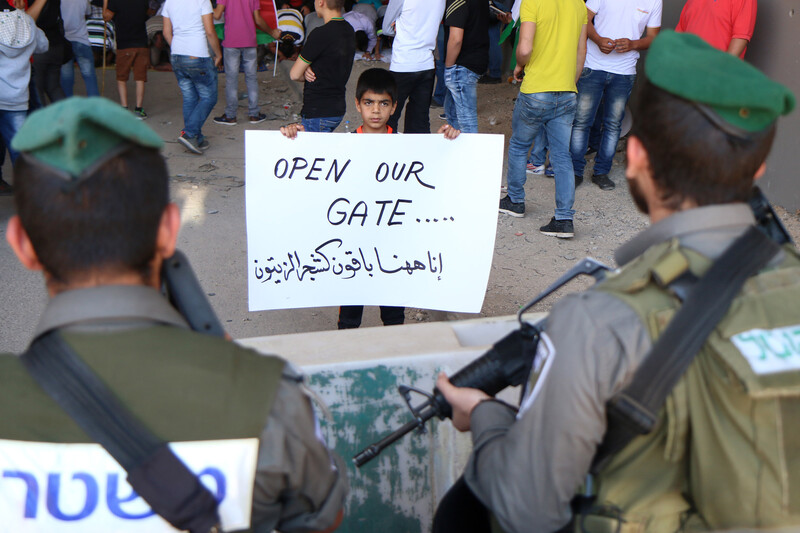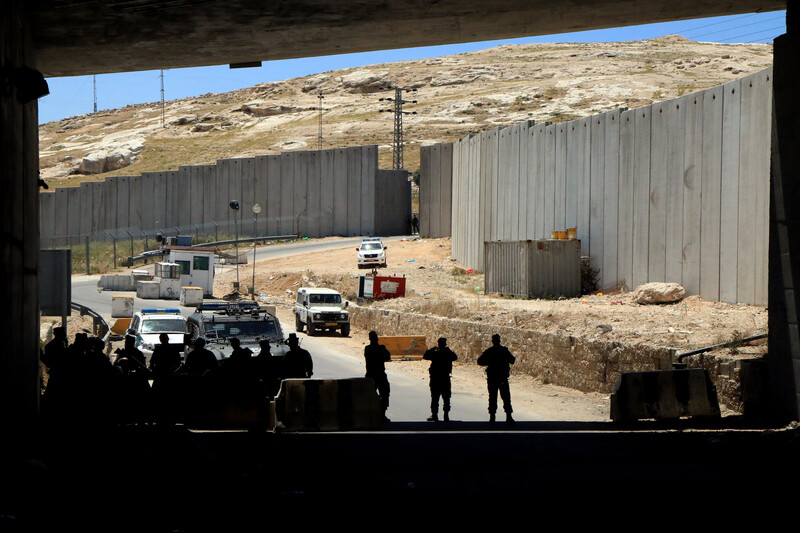The Electronic Intifada Jerusalem 18 May 2015

Palestinians protest Israel’s closure of the gate that leads from Jerusalem to al-Zaim village, 8 May.
ActiveStillsFor the past few weeks, the 6,000 people of al-Zaim have been locked behind a steel gate that forms part of Israel’s massive wall in the occupied West Bank.
Because the gate is only open for a few hours each afternoon, local children have to pass through a different exit than they normally would to attend school in nearby Jerusalem. A journey that should be no longer than 15 minutes can now take an hour.
Ashraf, one of al-Zaim’s residents, has to take time off from work to drive his six-year-old son. The boy had previously traveled to and from school by bus. But the gate’s closure means he would have to cross a busy highway if Ashraf did not drive him. “It is not safe at all,” said Ashraf.
The Israeli authorities have closed the gate since the evening of 24 April. The closure followed Israel’s killing of 17-year-old Ali Muhammad Abu Ghannam at a military checkpoint beside the entrance to al-Zaim.
The blockade has disrupted life in this community.
Cars wishing to enter al-Zaim must continue past a checkpoint on Highway 1 toward the Dead Sea. Then they have to look for the next exit for the Israeli settlement Maale Adumim, make a U-turn and head back toward Jerusalem again.
“Out of our control”
“I am losing this time from my life,” said Ashraf. “This is not a dangerous neighborhood, people here don’t make problems, they don’t throw stones. I want my son to get to and from school safely.”
Because public buses are no longer running into al-Zaim, businesses are also strained. The Atallah Wedding Hall has received cancellations for events booked three months in advance. Carwashes sit empty and one auto shop owner is considering closing for good. “I had to tell my workers to go home, there is nothing to do because no one will come here anymore,” he said.
The al-Zaim local council, headed by Naeem Sob Laban, has organized demonstrations at the gate each Friday since it was closed. Council members have held placards reading “We want to live free” and “This is a village, not a prison.”
At the most recent Friday demonstration on 15 May, children from al-Zaim stood at the front of a crowd of approximately 60. The protest was peaceful and closed with afternoon prayers.
When asked if he is hopeful at the prospect of opening the gate, Sob Laban said, “it’s possible if you ask for it.”

Israel closed the gate to al-Zaim village on 24 April after the killing of a youth.
Approximately 95 percent of al-Zaim residents have identity cards issued by the Israeli authorities that allow ID holders to travel to Jerusalem without obtaining permits.
This means that the people of al-Zaim have tended to have greater access to Jerusalem than those of some other Palestinian communities near the wall. Locals fear, however, that there could be long-term effects on their access.
On 10 May Israeli authorities called residents in al-Zaim, threatening to confiscate the blue Jerusalem ID cards of anyone who participates in the demonstrations. Al-Zaim’s local council has complained to the Israeli authorities.
According to Hamood, a local resident, the situation will probably worsen. “It is like an earthquake coming,” he said.
“We are living under a curfew, we are living in a big prison,” he added. “People here are scared to be happy, they are scared get their hopes up, because tomorrow can always be bad, and it’s out of our control.”
Jesse Rubin is an intern at the Palestine-Israel Journal and a freelance reporter living in Jerusalem. Twitter: @JesseJDRubin.





